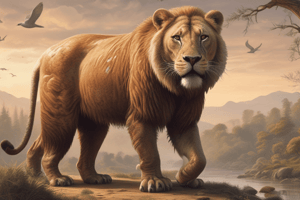Podcast
Questions and Answers
What is one of the importance of wildlife conservation?
What is one of the importance of wildlife conservation?
- To maintains ecosystem balance and biodiversity (correct)
- To provide a source of food for humans
- To support agricultural development
- To preserve historical monuments
What is one of the threats to wildlife?
What is one of the threats to wildlife?
- Establishment of zoos
- Construction of national parks
- Climate change (correct)
- Deforestation for agricultural purposes
What type of conservation strategy involves protecting species in controlled environments?
What type of conservation strategy involves protecting species in controlled environments?
- Habitat restoration
- Community-based conservation
- In situ conservation
- Ex situ conservation (correct)
What is the name of the international agreement that regulates the trade of endangered species?
What is the name of the international agreement that regulates the trade of endangered species?
What type of conservation involves local communities in conservation efforts?
What type of conservation involves local communities in conservation efforts?
What is the main goal of habitat restoration?
What is the main goal of habitat restoration?
Which organization is involved in wildlife conservation?
Which organization is involved in wildlife conservation?
What is one of the challenges in wildlife conservation?
What is one of the challenges in wildlife conservation?
What is one of the benefits of wildlife conservation?
What is one of the benefits of wildlife conservation?
What type of conservation involves re-establishing species in areas where they have become extinct?
What type of conservation involves re-establishing species in areas where they have become extinct?
Flashcards are hidden until you start studying
Study Notes
Wildlife Conservation
Importance of Wildlife Conservation
- Maintains ecosystem balance and biodiversity
- Preserves genetic resources for future generations
- Supports ecotourism and local economies
- Enhances human well-being and quality of life
Threats to Wildlife
- Habitat destruction and fragmentation
- Overexploitation (hunting, logging, fishing)
- Climate change
- Invasive species
- Pollution
- Human-wildlife conflict
Conservation Strategies
- In situ conservation: protects species in their natural habitats
- Ex situ conservation: protects species in controlled environments (e.g., zoos, seed banks)
- Habitat restoration: restores degraded habitats to their natural state
- Species reintroduction: re-establishes species in areas where they have become extinct
- Community-based conservation: involves local communities in conservation efforts
Conservation Organizations
- International Union for Conservation of Nature (IUCN)
- World Wildlife Fund (WWF)
- Wildlife Conservation Society (WCS)
- National parks and wildlife agencies
International Agreements
- Convention on International Trade in Endangered Species of Wild Fauna and Flora (CITES)
- Convention on Migratory Species (CMS)
- Ramsar Convention on Wetlands
- United Nations Convention on Biological Diversity (CBD)
Challenges and Opportunities
- Balancing human needs with conservation goals
- Addressing climate change and its impacts on wildlife
- Engaging local communities in conservation efforts
- Leveraging technology (e.g., camera traps, drones) for conservation
- Promoting sustainable development and eco-tourism
Wildlife Conservation
Importance of Wildlife Conservation
- Maintaining ecosystem balance and biodiversity is crucial for the health of ecosystems
- Preserving genetic resources ensures the availability of genetic material for future generations
- Ecotourism and local economies benefit from wildlife conservation, generating income and jobs
- Wildlife conservation enhances human well-being and quality of life by providing ecosystem services and promoting outdoor recreation
Threats to Wildlife
- Habitat destruction and fragmentation occur due to human activities like deforestation, urbanization, and infrastructure development
- Overexploitation of wildlife through hunting, logging, and fishing leads to population decline and extinction
- Climate change affects wildlife habitats, distribution, and behavior, leading to population decline and extinction
- Invasive species outcompete native species for resources, leading to population decline and extinction
- Pollution from human activities like industrial and agricultural practices harms wildlife habitats and populations
- Human-wildlife conflict arises from encroachment of human settlements into wildlife habitats, leading to injuries and deaths on both sides
Conservation Strategies
- In situ conservation protects species in their natural habitats through the establishment of protected areas and habitat management
- Ex situ conservation protects species in controlled environments like zoos, seed banks, and botanical gardens
- Habitat restoration restores degraded habitats to their natural state, promoting ecosystem recovery and biodiversity
- Species reintroduction re-establishes species in areas where they have become extinct, promoting ecosystem recovery and biodiversity
- Community-based conservation involves local communities in conservation efforts, promoting coexistence and shared benefits
Conservation Organizations
- International Union for Conservation of Nature (IUCN) is the global authority on the conservation status of species
- World Wildlife Fund (WWF) works to conserve nature and reduce the most pressing threats to the diversity of life on Earth
- Wildlife Conservation Society (WCS) works to protect wildlife and wild places in Africa, Asia, Latin America, and North America
- National parks and wildlife agencies manage and protect protected areas and wildlife populations at the national level
International Agreements
- Convention on International Trade in Endangered Species of Wild Fauna and Flora (CITES) regulates international trade in wildlife and plant species
- Convention on Migratory Species (CMS) conserves migratory species and their habitats
- Ramsar Convention on Wetlands protects and conserves wetlands of international importance
- United Nations Convention on Biological Diversity (CBD) promotes the conservation of biological diversity and sustainable use of its components
Challenges and Opportunities
- Balancing human needs with conservation goals requires sustainable development and resource management
- Addressing climate change and its impacts on wildlife requires reducing greenhouse gas emissions and adapting to climate change
- Engaging local communities in conservation efforts promotes coexistence and shared benefits
- Leveraging technology (e.g., camera traps, drones) for conservation enhances monitoring and management of wildlife populations
- Promoting sustainable development and eco-tourism supports conservation efforts and local economies
Studying That Suits You
Use AI to generate personalized quizzes and flashcards to suit your learning preferences.




